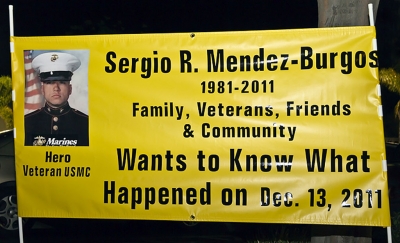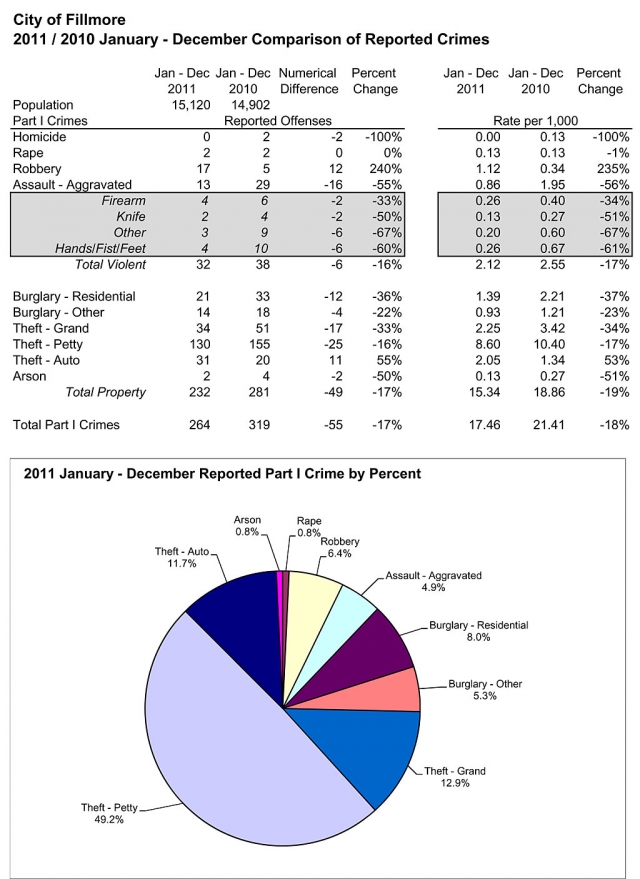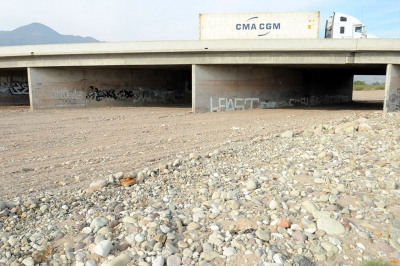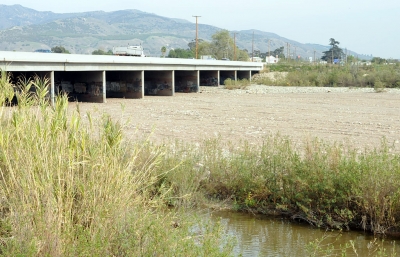|
By Anonymous — Wednesday, February 15th, 2012
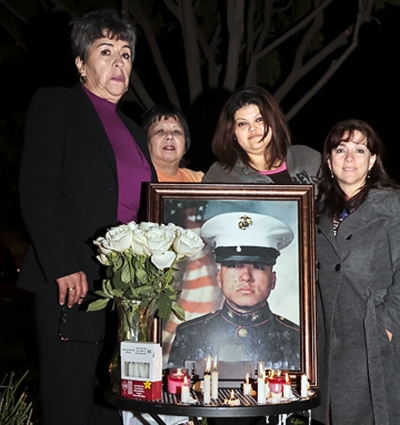 Family and friends attended a memorial vigil across from Starbucks Friday, to commemorate the death of Sergio Mendez who was killed in a bizarre accident. Pictured (l-r) Belen Burgos, Nathalie Bagasso Miliken, Cinthya Mendez, and Clara Quimbayo. Enlarge Photo A memorial vigil attended by family and friends of Sergio Mendez took place Friday evening across from Starbucks. Mendez, a former Marine, was sitting in the Fillmore Starbucks on December 13, 2011 when a vehicle traveling at high speed smashed through the building pinning him against an interior wall. Mendez died shortly thereafter during surgery at Ventura County Medical Center. Mendez aunts, Clara Quimbayo and Belen Burgos, told interviewers that they were seeking an “impartial investigation of what happened.” They are concerned that the investigation may be biased due to the fact that the Two months have passed since the incident and very few facts have been released, except for reports that “neither drugs nor alcohol appeared to be a factor in the crash.” The possibility of loss of consciousness is being investigated. The vehicle, westbound on Highway 126, crossed two lanes of traffic, jumped a curb, tore through a short hedge and traveled 130 yards through a parking lot before crashing through the east wall of Starbucks. Reports stated that family members were waiting for word from Ventura County District Attorney Greg Totten’s office as to whether or not criminal charges would be filed. |
|
By Anonymous — Wednesday, February 15th, 2012
|
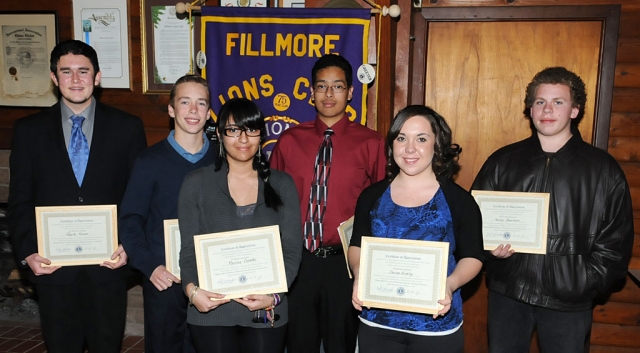 Monday night the Fillmore Lions Club held their Annual Speaker Contest. Pictured (l-r) Speaker winner Roberto Munoz with Nick Johnson, Marissa Dorantes, Jovanny Bravo, Darian Binkley, Wesley Brecheen. Enlarge Photo By Anonymous — Wednesday, February 8th, 2012
 Roberto Munoz, a senior at Fillmore High School, took first place for a third year in a row at the Fillmore Lions Club Speaker Contest. On Monday, February 6 the 75™ Annual Lions student speaker contest was held at the scout house with over 50 Lions, speakers, friends and family present. The topic on which they spoke about was “What could the America of yesterday teach the America of tomorrow?" |
|
By Anonymous — Wednesday, February 8th, 2012
Governor Edmund G. Brown Jr. today announced the following appointments. M. Cecelia Cuevas, 48, of Fillmore, has been appointed to the 31st District Agricultural Association, Ventura County Fair Board. Cuevas has been a senior financial advisor for Merrill Lynch since 2004. She was director of development and communications for the American Red Cross of Ventura County from 2002 to 2004 and development director for the Coalition to End Domestic and Sexual Violence from 1997 to 2002. She has served as mayor pro-tem for the City of Fillmore from 2006 to 2008 and city councilmember from 2000 to 2006. Cuevas is the immediate past president of the California Coalition Against Sexual Assault. This position does not require Senate confirmation and there is no compensation. Cuevas is a Democrat. |
 A westward view of the Fillmore bridge crossing Sespe Creek shows the recent cleanout of rock and debris at the center. Upland Rock has completed the work of grading and removing debris which accumulated over the years at the center of the bridge. The rock presents a flood threat for the western part of the city. Enlarge Photo By Jean McLeod — Wednesday, February 1st, 2012
Sespe Creek is getting a great deal of attention these days. In addition to the Ventura Watershed Protection District putting in a new levee, Upland Rock at Sespe Creek is also working on removing the large amount of collected debris blocking the channel under the east Sespe Creek bridge located on Highway 126. Sespe Creek, which originates above 5,000 feet elevation in the Los Padre National Forest, drains a major portion of the Sierra Madre Mountains and 342 acre of Sespe Wilderness into the Santa Clara River. The name Sespe can be traced to the Chumash Indian village, called Cepsey or Sek-pe in a 1791 California land grant. It was important to the native tribe, which foraged and hunted along the creek. Sespe Creek is the largest of the 30 tributary creeks running into the Santa Clara River, which is the longest relatively natural river remaining in Southern California. The Sespe is 51 miles long and joins the Santa Clara River in Fillmore through an east and west channel that both cross Highway 126. But, according to James Sandoval, owner of Sespe Materials (the company that mined the creek for many years), a significant flood years back diverted the water’s flow to the east channel. Sandoval, at the time, wanted to restore the flow to the west channel, but a Fillmore homeowner refused him needed access to do the work. Sandoval said, “It has been at least 20 years since the west channel has flowed.” The County of Ventura has designed and mapped out all rivers and creeks that flow within its boundaries which includes Sespe Creek. But in the past decade, several fires have burned hundreds of acres of the dense chaparral around Sespe’s watershed and the creek has been laden with considerable sedimentation which fills in many of the deep pools that the lower Sespe is known for. The debris and sediment deposits under the Highway 126 west Sespe Creek overpass (which is long and wide enough to accommodate two lanes in each direction plus and ample median and shoulders) are preventing a proper flow and shifting the streambed in both left and right directions of the designated map. This is also causing flooding of the ranches along its banks. Some areas of debris, which includes sand, rock and vegetation, have reached over nine feet high with the creek itself 14 feet above grade. One of the main culprits causing problems is the non-native plant Arundo, which has taken over large areas of both Sespe Creek and the Santa Clara River. A tall perennial, cane-like grass that resembles bamboo, Arundo is an invasive species that during flooding rhizomes break off and travel downstream where it continues to invade due to its aggressive growth and ability to survive. Once Arundo is established the area requires continual costly cleanup and maintenance because it creates a fire hazard, flood hazard, sedimentation, and erosion. The plant collects at bridges, drainage pipes and other flood control structures, causing compromised functioning and in some instances structure failure along with degrading the natural resources. As the plant spreads the areas stop functioning as native systems. The entire ecological cycle of the riparian system is impacted which includes the habitat that plants, birds, fish, animals and insects rely on. A number of agencies (Cal Trans, Ventura County Watershed Protection Dept., California Fish and Game, just to name a few) have a responsibility for keeping the Sespe water flowing properly, but because of the expense involved it is not a high priority. To Fillmore it is a safety issue, which is a high priority. Flooding creek waters can move boulders as large as 20,000 lb creating dammed up areas and flooding, but it is also a danger to bridges or any other structure in the way. The trusses supporting the Sespe Creek overpass have already sustained damage in the past due to buildup and were repaired by Sandoval. Because of the financial state of both the State of California and Ventura County, the funding for cleaning out the creek is put at the bottom of the list. Many municipalities have started looking to partner with private companies to help offset the costs. This is where Mike Grabowski and Rocky Dreher, owners of Upland Rock steps in; opening up the Sespe Creek channel helps the environmental habitat by extracting the marketable material (boulders, gravel and sand) for sale to local businesses, and helps lower the costs to those responsible municipalities. But, growing environmental concerns and opposition to mining have had an impact on the mining industry and a loss of local mining business in Ventura County. Rock and sand materials have for years been transported from mining companies extracting materials from the deserts of Palmdale and Lancaster; but transportation adds to the cost of those materials. Today’s approach to mining is more environmentally friendly but there is still a need to supply the growing demand for materials at a cost the consumer and taxpayer can afford. Having Upland Rock as a local supplier brings down transportation costs of the materials used to build our local roads, bridges, building, homes and numerous other applications. Taking on such a project is not a simple task due to the numerous municipalities involved and all the regulations. Biological monitoring is required prior to disturbing the site as well as a biologist on site, at a cost of $1,000 per day, while work is being preformed. The confluence of Sespe Creek with the Santa Clara River provides an important connection to upland systems and migration of the wildlife that depend on a free flowing waterway. Any disturbance of the creek brings environmental issues of protecting a number of endangered species such as the Arroyo toad, California Red-legged Frog, California Condor, Southern Steelhead Trout, songbirds Southwestern Willow Flycatcher and Least Bell’s Vireo. Currently, most of the creek is closed to fishing due to efforts to reestablish a Steelhead run. Before Upland Rock could proceed with the cleaning out the creek an extensive list of engineering and environmental studies had to be prepared and approved. These included: Conditional Use Permit approved by the Ventura County Resource Management Agency; Reclamation Plan and Financial Assurance Bond approved by the California Department of Conservation, Office of Mine Reclamation; Section 404 Permit approved by the U.S. Army Corps of Engineers; Special conditions from the National Oceanic and Atmospheric Administration’s National Marine Fisheries Service were incorporated into the project to reduce the impacts to steelhead trout that migrates up the Santa Clara River to spawn in Sespe Creek and other critical habitat; Lake or Streambed Alteration Agreement approved by the California Department of Fish and Game, which includes a Mitigation, Re-vegetation and Biological Protection Plan; Water Quality Certification approved by the California Regional Water Quality Control; Encroachment Permit approved by the Ventura County Watershed Protection District; Encroachment Permit approved by the California Department of Transportation; Permit to Operate approved by the Ventura County Air Pollution Control Board. Each of these municipalities with their own concerns and regulations rarely communicate with each. To get all the agencies “talking” to one another Upland Rock hired Sespe Consulting added an additional 40% to the projects operational costs. Regulations require the work can only be done when the water is 75 degrees or above (the water in Sespe Creek can warm by 20 degrees over the course of the day) and the creek’s flow is low, leaving few days or hours to work on the project, usually the only months when work can be done is November through December. Snow pack and year-round running springs supply the stream with a constant flow. Historically the highest crests have been January through March with February 10, 1978 recording the highest at 22.40 feet and the lowest level on record was 3.44 feet on September 1, 2004. Upland Rock started the project the week before Thanksgiving and was given 15 days to complete it with a one week extension for just cleaning up and no mining. In addition to all of the agency approvals, environmental mandates require that the water may not be disturbed by the project. To accommodate this, railroad cars, which are strong enough to care a heavy load, were stripped of their siding and the undercarriage used to create bridges over the streambed to carry the 35 ton equipment needed to extract the rock and sand. Also no chlorinated water may be added to the creek, only the creeks water may be used to wash the materials and equipment, so pumping equipment for that purpose needed to be brought in and used. The vegetation along the creek consists of typical riparian species such as Willow and Cottonwood which Upland Rock carefully harvests and propagates into containers for replanting when the work is completed. During the Nov-Dec 2011 phase over 100,000 cubic yards of material was extracted, but with the creek still being 14 feet above grade, a great deal of material needs to be extracted in the future. Upland Rock will be returning in December of this year to start phase 2. This is not the first time the debris has been cleaned out. Sandoval, who also owns Blue Star Materials in Moorpark, had done the cleanup from 1992 through 2010. Last year Upland Rock took over the remaining six years of a 25 year Conditional Use Permit originally issued to Sandoval and will continue the cleanup for the permit’s remaining five years, as long as the price of rock and sand make it financially feasible. The cost for Upland Rock to take over the project was $150,000. If Upland Rock had not taken over the project from Sandoval and had to start from the beginning the costs would have been between $200,000- $500,000 and probably not something the company would have considered taking on. |
|
By Anonymous — Wednesday, February 1st, 2012
On Saturday, January 14, 2012 Brian Ball, a 2003 graduate of Fillmore High School, competed in his first Olympic Marathon Trials in Houston, TX. On race day 123 athletes were registered to run and out of that group 114 showed up at the start. Only 85 runners completed the race. Brian finished in 39th place with a time of 2:17.38. He is the training partner of 2004 silver medalist and 2009 New York City Marathon Champion, Meb Keflezighi who won the Trials and will compete in his third Olympics. Brian has been training for the last three years in Mammoth Lakes, CA. Brian started his running journey in high school as a sprinter/middle distance runner competing primarily in the 200 and 400-meter events. He ran cross- country his senior year to get in shape for track season. He was the number three or four man on a team that won league and got second at the state meet. During college at BIOLA University, he ran cross- country and track. He was injured his first track season but began his second year running the 800/1500. His final two seasons he competed in the 5k and 3000-meter steeplechase. He was a six time NAIA All American (3 years cross country/ 3 years track) while at BIOLA. After a successful college career, he still had the desire to compete and felt he hadn’t reached his potential. With the encouragement of his parents, he headed off for Mammoth Lakes to train in altitude. Not knowing anyone, he trained alone for a month before he saw some of the Mammoth Track Club runners and was invited to a work out. Josh Cox, Olympians Ryan Hall, Meb Keflezighi and Dan Browne a former Westpoint graduate and current Major in the US Army accepted Brian into their group. He has trained primarily with Meb and Dan the past three years with the help of former Hall of Fame Coach at UCLA, Bob Larsen. Bob has coached Meb since his college days at UCLA. Brian feels very blessed to have Meb and Dan as friends that share his Christian faith and a common interest in running. They have become his mentors. |
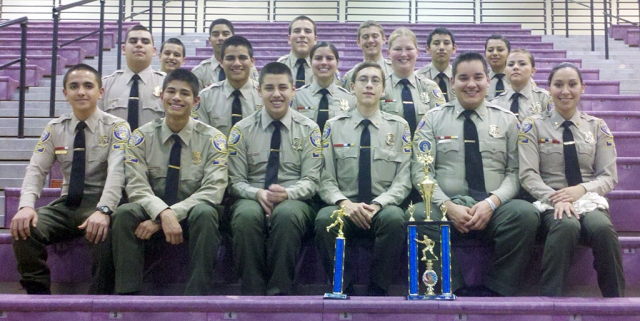 Pictured (l-r) front to back: Michael Topete, Armando Vidal, Javier Salgado, Tyler Hackworth, Eddie Gutierrez, Josefina Fernandez, Christian Robledo, Alan Galvan, Briana Vazquez, Jessica Givan, Daisy Villa, Zachary Saint Pierre, Khristian Felix, Brandon Pina, Daniel Flores, Miguel Salgado, and Maria Salgado. Vidal also placed 2nd in the 3 mile run. The whole unit placed 4th in the “Rapid Response Scenario”. Enlarge Photo By Anonymous — Wednesday, February 1st, 2012
For the past 14 years, the Chandler Police Department has hosted a Tactical Explorer Competition. The event has become so popular that the number of Explorer Posts that can participate is limited to 65. Explorer posts throughout the Country travel to Chandler to compete. Three Explorer Posts from the Ventura County Sheriff’s Office competed this year: Headquarters Station Post #2902, Camarillo Post #2932, and Fillmore Post #2958. The Explorer Scouts participated in a variety of pseudo SWAT (Special Weapons and Tactics) scenarios. The Explorers from the Ventura County Sheriff’s Office were awarded the following trophies. Post #2902: 1st Place – Tug o’ War, 1st Place – Marijuana Field Raid, and 5th Place – EOD (Explosive Ordinance Disposal) Response; Post #2932: 5th Place – 10 Man TK-4 (Armored Vehicle) Pull; and Post #2958: 4th Place – Rapid Response (Active Shooter) and 2nd Place – 3-Mile Run, which is an individual event completed by Armando Fidal. Each Explorer Post is affiliated with a law enforcement agency and Learning for Life, which is a branch of Boy Scouts of America. Many law enforcement agencies support the Explorer Program it provides an opportunity for youths to have a positive impact on their communities as well as develop future peace officers and good citizens and leaders. For more information about the Explorer Program for the Ventura County Sheriff’s Office, please contact one of the following Advisors: Headquarters – Deputy Sara Valenzuela (805) 654-2364, Ojai – Deputy Quincy Knowlton (805) 646-1414, Fillmore – Senior Deputy Mario Aguilar (805) 524-2233, Camarillo – SST (Sheriff’s Service Technician) Todd Eskridge (805) 388-5129, Thousand Oaks – Senior Deputy William Hutton (805) 497-2351, and Moorpark – Deputy Claudia Holden (805) 532-2700. |
|
By Jean McLeod — Wednesday, January 25th, 2012
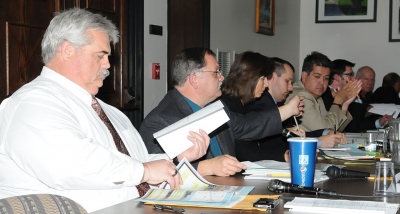 Council members sat in a large circle with audience members at the "Town Hall" style meeting. Enlarge Photo 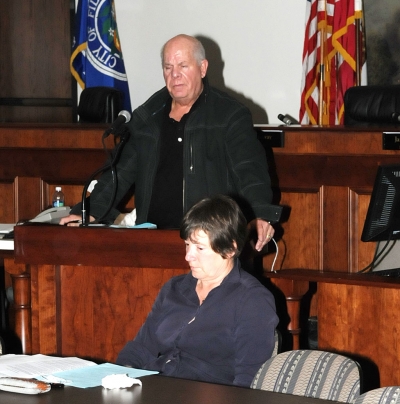 (top to bottom) Former Fillmore City Manager, Roy Payne, and current City Manager, Yvonne Quiring. Editor's Comment: "Roy built the city for 20 years; Yvonne stirs the ashes. If Roy and Bert Rapp were here again, and the Katzenjammers gone, Fillmore would rise again from those ashes." Enlarge Photo Unlike most Fillmore City Council meetings, this one, held Tuesday, was much more relaxed and used a roundtable setting with the Council Members seated among those in attendance. Many spoke of the comfortable atmosphere and thanked Councilmember Brian Sipes for suggesting it. There were a number of items on City Council/Town Hall Meeting agenda which included the: Sespe Creek Levee, the Business Park, Redevelopment Agency/Budget, the high school running track, Economic Development, and VC Alert System (see “Ventura County replaces and upgrades reverse 911 system” – front page). Peter Sheydayi and Norma Camacho from the Ventura County Watershed Protection District (VCWPD) gave a presentation on future plans for addressing the FEMA 100 year flood hazard zone in Fillmore and bringing the standards up to meet today’s required federal flood protection. The contributing factors impacting Sespe Creek that make the new upgrade necessary are; peak flow rates have increased by 35% compared to the original levee design, shift in the dominant alluvial channel in the active streambed from west to east fork, active channel subject to resetting after major storm events, long-term sediment deposition and local erosion. There are two sections of the flood area that do not meet today’s higher standards and require improvement. This includes having a minimum of three feet freeboard (safety factor) above the Base Flood along the length of the levee and an additional one foot within 100 feet of structures—such as bridges or wherever flow is restricted. All systems must also have closure devices that are structural parts of the system during operation and no appreciable erosion of the levee embankment can be expected during a Base Flood. The existing levee was completed in 1981 and the largest flood on record to pass through occurred on January 10, 2005 and reached the peak. Research has shown that the levee below Old Telegraph would be overtopped during a large storm event. To bring it up to standards the project will take 30-45 days at a cost of $1,528,000 which would normally be paid by the City. But with the financial problems the City is dealing with there aren’t funds available for the project. Fillmore City Manager Yvonne Quiring spoke to VCWPD and explained the hard financial situation the town is facing. The VCWPD did the town a service and applied for a $2.8m grant to cover the project, which also includes restoring any damage done during the project. When the project is completed FEMA will do a revision of Fillmore’s flood plane map. Council Member Jamey Brooks told the representatives, “On behalf of the homeowners I’d like to thank you.” Rod MacDonald with KDF Communities spoke to the Council on the need to bring businesses to Fillmore. He said of the lack of undeveloped commercial property in the County, due to the Save Our Agricultural Resources Act (SOAR), Fillmore has a great deal of land that is still available at half the price of other towns like Valencia. MacDonald said Fillmore needs to establish itself as an industrial area adding, “Fillmore is untested on Hwy 126 and has tremendous opportunity…. with a workforce that is available.” MacDonald went on to say, “Fillmore is the most beautiful area I’ve seen in Southern California……what it doesn’t have is jobs….you need to put the flag up and say you’re business friendly…we don’t need a lot of bureaucracy or push back.” He reminded the Council that the City reached out for this project and paid for the Environmental Impact Report adding it was a tremendous endeavor by the City; the City realized jobs were needed here. MacDonald also spoke of the need for continuity and what a great loss it was when of Bert Rapp resigned along with so many of those who had knowledge of Fillmore’s past and present development projects including the Business Park. Continuity is important, he told the Council. Former City Manager Roy Payne spoke in regards to the Business Park, saying that Fillmore is ahead of the game this time since everything has been approved and stated, “I am confident we are ready to move forward.” Bruce Stenslie from the Economic Development Collaborative of Ventura (EDCV) addressed the Council and also spoke of the need to attract more business to Fillmore and what the EDCV has to offer such as financing loans. They are also working on expanding the film industry outreach in the County and have a new website http://venturacountyfilm411.org/. Quiring gave an updated presentation on the budget and what is known of Gov. Brown abolishing all Redevelopment Agency (RDA) and the required liquidation of all its assets. According to Quiring and many others it was done by Brown in retaliation of Prop. 22 which was passed by voters and took away the States ability to siphon off revenue generated from the RDA’s. She gave a breakdown of where Fillmore’s General Fund receives monies and where that money goes. The largest source of revenue is property taxes which brings in $1.9 million. The remaining sources are: sales tax $670,000, fees for services $468,000 (approx. $200,000 development related), Franchise fees $331,000, license and permits $14k, grants $99,000, Transportation Occupancy Tax, fines and forfeitures $62,500. The services provided by the General Fund are: Police/Sheriffs $3.1 million, Fire Dept. $785,000, Parks $100-$150,000, Recreation and Pool subsidy $100,000, Finance/City Attorney/City Manager/City Council, Community Development (Planning), Public Works (streets, trees, sidewalks). Quiring explained the four main issues that have had a devastating impact on Fillmore’s finances: Expenses have risen faster than revenue, medical insurance costs went up 13%, cost of Police increased $250,000 in the past two years, and pension costs rose (employees are picking up increased costs this year). The net impact to the General Fund after dissolving the RDA is not yet known. But the most pressing problem is that the General Fund received $864,000 from the RDA in the past. Instead, about $500,000 will be available, which is $364,000 less this year. The City has cut $2.9 million and used its reserves in the last two years to balance the budget while today the General fund has seen a decrease of 40%. This year’s budget was balanced using $620,000 from the General Purpose Reserve with roughly $916,000 remaining. The RDA is paying $376,000 for salaries and benefits and $488,000 to the General Fund in transfers; the total comes to $864,000. The projected City deficit for fiscal year 2013 is $1.4 million. This would have a dramatic impact on Fillmore. The cuts, if the City does see the $1.4 million deficit, would be to all non-supporting recreation programs: graffiti removal, police or contracting with another agency, fire services or let County provide protection, closing parks, no street repair, no tree trimming, reduced Code Enforcement and closing the pool. Another item that brought a number of speakers to address the Council with their concerns was the installation of an access gate to the Fillmore High School running track. John Scoles told the Council there are many residents interested in the track and they are looking to the Council to solve this problem which has been an ongoing plea for 3 ½ years. He asked that the City go forward with the $8,000 financing of the access gate and agree to be reimbursed later by those using it. Mayor Gayle Washburn replied, “It boils down to funds, we don’t have the funds.” Scoles said there is a substantial number that would support the financing of the track. The revenue would come from the $25-$50 yearly dues runners would pay and the Sunrise Rotary Club would help with fundraising. Scoles stated, “I’m 70 years old, I’d like to use the track before I’m 73.” Cindy Blatt representing the Rotary Club said they would take the lead to raise the funds and solicit other clubs to join in the fundraising. “Our goal is to raise the funds…that’s our commitment, and to start I’ll donate $100.” Joan Archer spoke on how the issue of the track has been “bounced back and forth between the School Board and the City Council for over three years without resolution until recently when the school board approved a public access gate which they will install at an agreed upon location after the City pays for it. The next move is up to the City.” She went on to say that over the last three years the Aquatic Program has resulted in a deficiency of about $385,000 and that the city should reevaluate that program in light of the City’s financial situation. Archer stated that there isn’t a profit and loss analysis for the Lap Swim Program, which she stated an estimated 14-16 people participate in annually and although participants pay $4 per session, a pool manager and two lifeguards must be on duty at a combined rate of $38 per hour. “After learning what the revenue received from the Lap Swim Program was for the last three years, estimating the hours the pool was open during that time, and calculating the combined staff hourly rate of pay, I was able to determine that the operation of the program has resulted in a deficit of at least $16,000 over the last three years. If the City cannot afford a one-time expense of $8,000…that more than 150 citizens say they want, how can the City operate a Lap Swim Program…that has already cost the City at least $16,000 and is scheduled to reopen next month?” Archer asked the council. Fire Captain Rigo Landeros announced the new VC Alert system that began this month replacing the Reverse 911 system. The new system will alert registered participants by email, text, cell phone, home phone, work phone, facsimile or instant messaging. There are three ways of registering: online at www.vcalert.org or calling 805 648-9283 or by mailing in the form that’s available at City Hall. In addition to emergency information those registered can receive messages regarding crime alerts, road closures, public meetings or other community events. They can choose the location to be contacted and receive information about their home, parent’s home, workplace or child’s school. A correction to the January 10, 2012 article which stated the vote for the Council seat given to Eduardo Gonzalez was 3-1 with Sipes voting No. The correction is the vote was unanimous with all Council Members voting Yes for Gonzalez. |


